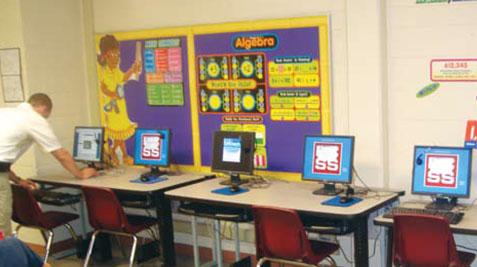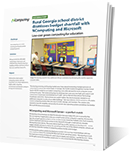CASO DE SUCESSO
Rural Georgia school district dismisses budget shortfall with NComputing and Microsoft
Low-cost green computing for education
The slowing economy and housing market woes have placed tremendous budget pressure on school districts across the United States. In Georgia, the 16,000-student Dougherty County School System (DCSS) needed to cut student computing costs while demand for more computer access continued to grow. “We looked at buying new desktops, but costs were too high, and support and maintenance would have overwhelmed our IT staff,” said Les Barnett, Educational Technology Coordinator with DCSS. “And we knew we couldn’t deliver the electrical power needed to run additional computers in a few of our older buildings.” Like most districts, DCSS wanted an affordable student computing solution that was easy to install, manage, and maintain. The solution also needed to have the reliability and security of a server-class operating system and deliver the familiar Microsoft Windows environment.

NComputing saved DC SS an additional $300 per workstation by eliminating the need for expensive computer tables.
NComputing and Microsoft Server—a perfect match
NComputing virtual desktops are ideal for education because today’s PCs are so powerful that the vast majority of applications only use a small fraction of the computer’s capacity. NComputing taps this unused capacity so that it can be simultaneously shared by multiple users. Each student’s monitor, keyboard, and mouse connect to the shared PC through a small and very durable NComputing access device. The access device itself has no CPU, memory, or moving parts—so it is rugged, durable and easy to deploy. By spreading out the cost of the shared computer, schools can provide four times the number of computing stations for the same budget.
DCSS found the perfect solution by deploying multiple NComputing virtual desktops with low-cost, small form-factor PCs running the Microsoft Server operating system. “NComputing is much less expensive in terms of initial cost, and is easy to deploy and maintain,” said Mr. Barnett. “While we thought a server OS would be complicated, we discovered that the NComputing solution using Microsoft Server on standard PCs was easy. All of our applications run smoothly in a server environment with no modifications. The system is so stable that our teachers can keep their computers running without support from our IT staff. We also found that NComputing and Microsoft Server improved our identity and access management.”
“There’s a perception that server software is more expensive, but that’s not the case for education because Microsoft offers substantial discounts through its Open and Select academic licensing programs,” said NComputing CEO Stephen Dukker. “Combining Microsoft Server with NComputing brings the cost of computer access below even the most heavily discounted school laptop solution.”
DCSS initially deployed 1,500 seats in classrooms and computer labs in seven schools. “NComputing saved us tens of thousands of dollars just on our initial hardware and software investment,” said Mr. Barnett. “With the academic pricing on Microsoft Server, we saved money and we’ve noticed that the number of IT work orders we get from those schools has been cut dramatically. We haven’t had a single instance of NComputing hardware failure, and no more blue screens from our computers!”
IT gets easier as classrooms go green
DCSS found that the NComputing virtual desktops solved another significant problem. In the past, the heat generated by PCs would make classrooms and computer labs too hot for students to study comfortably. The NComputing virtual desktops use less than 5 watts of power (compared to 110 watts for a PC) and generate almost no heat, which make the rooms much cooler. That reduces the need for air conditioning, saving even more money. “We estimate that we’ll save at least $52,000 per year in energy costs when NComputing is fully deployed in our schools, possibly quite a bit more,” added Mr. Barnett. “Best of all, we are able to meet demand for computer workstations in our older buildings without overloading the circuits.”
The NComputing devices mount on the back of monitors so they don’t take up valuable desk space. Instead of spending $300 for computer desks with keyboard trays and PC racks, DCSS now buys sturdy, inexpensive utility tables, saving thousands of additional dollars. “We have made more workstations available to our students and improved their user experience, while lowering our costs and cutting our energy use. We are committed to deploying the NComputing solution, and will eventually equip all of our labs and classrooms this way,” concluded Mr. Barnett.
Suggested reading




